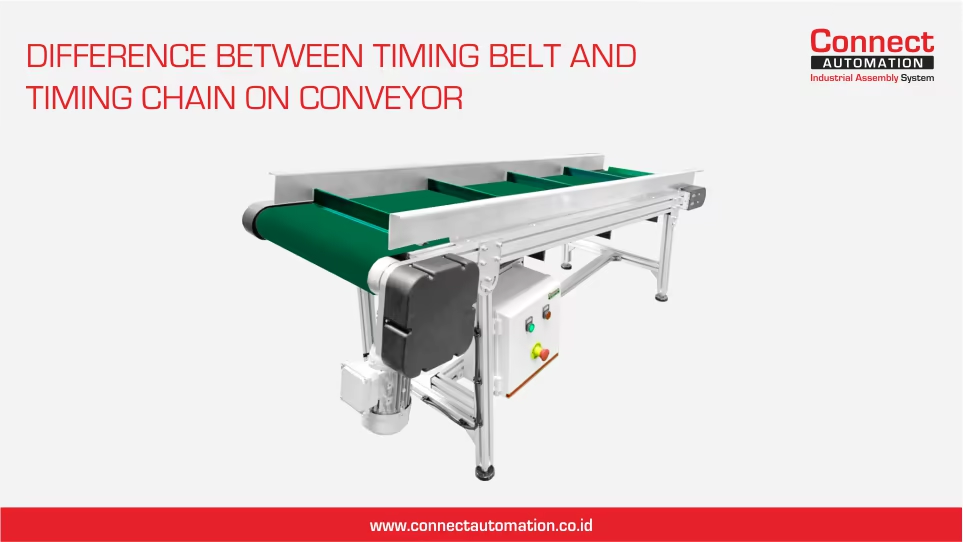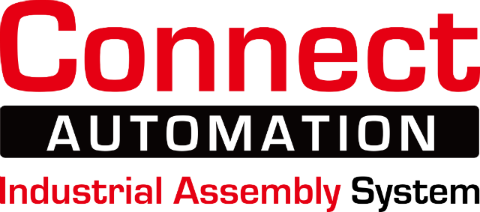REQUEST A FREE ESTIMATE!
Difference Between Timing Belt and Timing Chain on Conveyors

The use of timing belts and timing chains are two different types of mechanisms used in industrial applications for the purpose of transferring power and controlling the movement of materials. In terms of material, the resulting work performance is also different. Although both have similar functions, there are marked differences between them in terms of design, benefits, and usage. It is very important for you to know the differences, uses and advantages of each timing belt and timing chain on conveyors.
Timing Belt
The timing belt is one of the components in the conveyor driving machine. This component functions to maintain engine performance by synchronizing the rotation of the crankshaft and linkage shaft so that the engine valve can open and close at the specified time. The belt is equipped with teeth that mesh with the pulley to provide precise motion control. Timing belt conveyors are widely used in industries that require precise positioning and smooth operation, such as packaging, food processing and pharmaceuticals.
Timing Belt Materials
The material used to make timing belts is rubber with hard teeth so that it can mesh with the camshaft and crankshaft gears. This can allow the engine valves to open and close properly. Apart from that, the timing belt also plays an important role in preventing the piston from hitting the valve in an engine that is experiencing problems. There are two main components in a timing belt. First, a formed cable is inside which functions to carry the torque load. Second, the plastic compound used to shape the teeth and cover the wires themselves. Apart from these two components, there are other components, namely the timing belt strap which is made of fiberglass, polyester or Kevlar.
Advantages of Timing Belts
The advantages of using a timing belt are that it is quiet, has minimal vibration, produces precise movements with accurate timing, easy maintenance, constant speed ratio, does not slip easily, is resistant to abrasion, rust, as well as chemicals and contaminants, and of course economical. energy and costs. But of course, timing belts also have disadvantages, including high cost, low power used so they can only be used for relatively small distances.
Timing Chain
This is different from the timing chain which is made from an iron chain connected to a conveyor and driven by a motor so it looks sturdier and stronger. Timing Chain has the same function as a timing belt, but both have different characteristics. It can be seen from the two materials used. The timing chain has the advantages of being stronger so it is often used to transport heavier goods, its service life tends to be longer, it has a longer transfer power, and the material is sturdier because it is made of metal or iron so it produces a louder sound. Behind that, the timing chain also has disadvantages if it is not properly maintained, the chain used corrodes more quickly, the load it causes is also heavier, and most importantly, if damage occurs the impact can be comprehensive.
Advantages of Timing Chain
The advantage of using a timing chain conveyor lies in its ability to handle heavy loads without compromising accuracy or reliability. Its sturdy construction ensures long life even in harsh conditions. Additionally, the design allows for easy maintenance and replacement when necessary. On the other hand, the advantage of using a timing belt conveyor lies in its quieter operation due to reduced vibration compared to a chain conveyor. It also offers excellent positioning accuracy while maintaining flexibility for a wide range of applications. In short, timing chain conveyors and timing belt conveyors play an important role in industrial environments by providing reliable motion control solutions. The choice between the two depends on specific application requirements such as load capacity, precision requirements and environmental conditions. Understanding the benefits, advantages and proper use of each type can help businesses optimize material handling processes effectively.
Timing Belt and Timing Chain Conclusion
The use of timing belts and timing chains for conveyor components has different characteristics in terms of material and work performance. Both of them have no particular features that can differentiate which one is the best, it all comes down to your needs.
If you have questions regarding timing belts and timing chains on conveyors, please come and consult with us, FREE!!
Connect Automation specializes in providing automation solutions, including conveyor systems, to improve efficiency across various industries. The company delivers cutting-edge technology to help organizations automate tasks and optimize workflows. Connect Automation helps businesses reduce manual efforts, boost productivity, and achieve better outcomes. With a customer-focused approach, the company designs tailored solutions to ensure smooth and effective automation transitions for long-term success.
Kawasan Industri Jababeka Tahap 1, Jl. Jababeka II D Blok C14L Cikarang, Indonesia (17530)
(021) 893 5060 Google Maps
Rungkut Industri III, No. 37, Rungkut Menanggal, Kec. Gn. Anyar Surabaya, Indonesia (60293)
(031) 9985 8624 Google Maps
